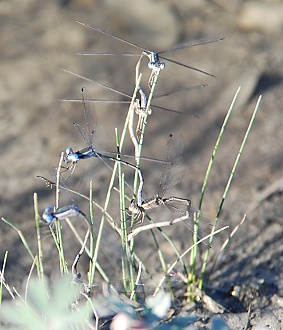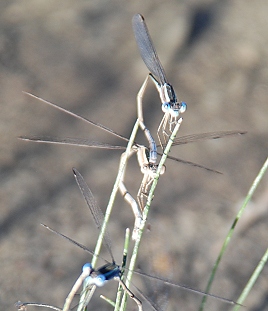The first odes of spring showed up after the rain, not surprisingly: the first was a tiny Citrine Forktail male seen flying from one (too brief to grab a shot) perch on dead week stalks sticking out of water, late Sunday. On Tuesday evening, behind the #3 gabion, I spotted three pairs of Plateau Spreadwings*, Lestes alacer, all trying to oviposit on one tiny clump of Eleocharis…the only clump that had greened up.

Spreadwing Damselflies ovipositing
The third female is out of sight behind that blurred leaf at the bottom (you can just see one eye and a few segments of abdomen.) The males have bright blue eyes and a pale blue or pale green stripe on the thorax; the females are shades of brown/tan/beige.

The male holds on while the female makes a slit in the stem of the plant and inserts eggs. These stems are so thin it’s hard to imagine any room for eggs inside, but after the long drought, no water plants with thicker stems had emerged from last week’s rain. Only this single little clump. Unfortunately, we’re not expecting any rain, and it’s already warm–the little rain pool behind the picture is already drying up/sinking into the soil.
I spotted a male Common Bluet at another rain pool, but the pictures weren’t clear enough to post.
*EDITED: The spreadwings were IDed as Plateau Spreadwings by Dennis Paulson, from the TexOdes list, via email. Thanks!
Comment by cdozo — March 22, 2009 @ 9:11 pm
These are wonderful pictures. I didn’t know that odes lay eggs that way. I thought they laid them in water. Do different kinds lay eggs in different ways?
Dragonflies and damselflies are beautiful, but they are frustrating for me to learn about because there are so many details.
I like this blog, but I wish it had a spell checker for comments. :-/
Comment by elizabeth — March 23, 2009 @ 8:03 am
Different odes do lay differently–very differently. I was surprised to see these little guys (gals?) laying in such skinny stems.
Some lay directly in water; some put their eggs on aquatic plants underwater (the females perch on the plant or a stick above water and stick their ovipositor onto the underwater part. Some “splash” their eggs onto waterside plants (I have photographs of a Neon Skimmer splashing, and the eggs coming out–pure blind luck, that set of pictures.)
You’re right, it’s a complicated bunch of animals with a lot of details to learn, but (I’ve discovered) it’s nothing to beetles. Beetles are *incredibly* detail-oriented! I thought the odes had prepared me for anything (and I certainly don’t know all about odes) but beetles…yikes.
What I did (the way that worked for me, with odes) was to start with the simplest: learn to “see” dragonfly v. damsel (and then, grumbling, add “spreadwing damsel”), and then the more obvious easy dragons like Neon Skimmer vs. Roseate Skimmer vs. Common Green Darner, then work my way toward the others.